Instituto Nacional de Investigación Agropecuaria
INIA EN ACCIÓN: presencia territorial y visión a largo plazo. [Editorial].

"Desde el Instituto Nacional de Investigación Agropecuaria (INIA), asumimos la responsabilidad de elaborar una propuesta institucional sólida, con prioridades claras, fundamentación técnica y rigor económico, que permita posicionar al instituto como un actor estratégico, comprometido con los grandes desafíos del país.
Una propuesta que pueda ser comunicada con claridad, rigor y creatividad a la ciudadanía y a quienes toman decisiones." -
Ing. Agr. PhD Miguel Sierra Pereiro, Presidente Junta Directiva de INIA.
El impacto de INIA en los últimos 20 años fue el eje de un estudio realizado por externos y financiado por el BID que arrojó datos relevantes.
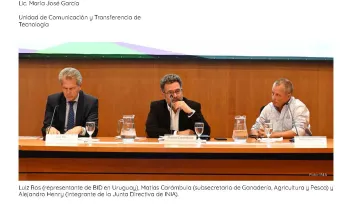
El Instituto Nacional de Investigación Agropecuaria (INIA) y el Banco Interamericano de Desarrollo (BID) organizaron un evento para presentar ante autoridades, referentes del agro y socios estratégicos los resultados del estudio "Evaluación de impacto de la investigación del INIA (Uruguay)", realizado por consultores externos
Nuevo Director del Sistema Arroz-Ganadería: Ing. Agr. PhD Jesús Castillo.
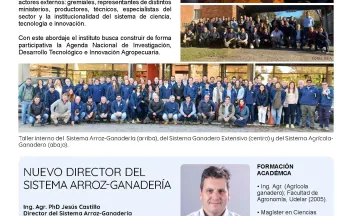
Jesús ingresó a INIA como investigador en el año 2011, luego de desempeñarse como asesor técnico privado. Desde febrero de 2025 dirige el sistema Arroz-Ganadería, continuando con la generación de conocimiento aplicado, tanto en el marco de proyectos institucionales como en asociación con empresas privadas. Parte de esta investigación se ha desarrollado directamente en campos de productores, también en estrecha colaboración con la industria.
XXI Taller de Evaluación de Zafra de Arroz: récord de producción y fuerte articulación del sector.
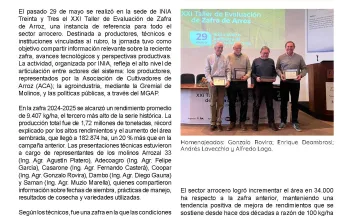
El pasado 29 de mayo se realizó en la sede de INIA Treinta y Tres el XXI Taller de Evaluación de Zafra de Arroz, una instancia de referencia para todo el sector arrocero. Destinada a productores, técnicos e instituciones vinculadas al rubro, la jornada tuvo como objetivo compartir información relevante sobre la reciente zafra, avances tecnológicos y perspectivas productivas.
Plan Estratégico Institucional 2026-2030.
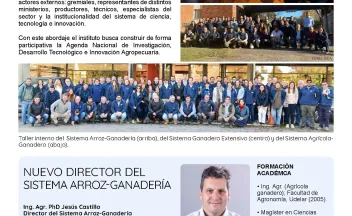
INIA está trabajando en la elaboración de su nuevo Plan Estratégico Institucional (PEI) 2026-2030.
Jornada técnica. Sensoramiento remoto para la gestión sostenible del agro.
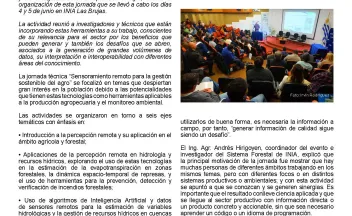
El interés que despierta el uso de sensores remotos y de Inteligencia Artificial aplicados al agro, motivó la organización de esta jornada que se llevó a cabo los días
4 y 5 de junio en INIA Las Brujas. La actividad reunió a investigadores y técnicos que están incorporando estas herramientas a su trabajo, conscientes de su relevancia para el sector por los beneficios que pueden generar y también los desafíos que se abren, asociados a la generación de grandes volúmenes de datos, su interpretación e interoperabilidad con diferentes áreas del conocimiento.
